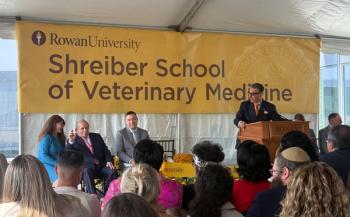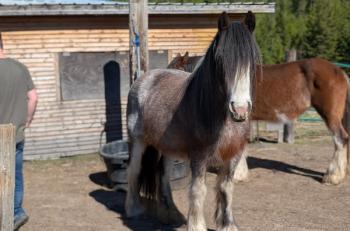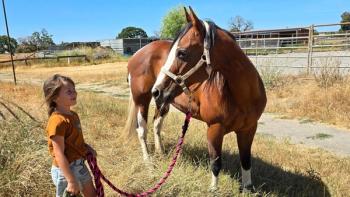
Non-exertional myopathies, atropy, and fasciculations (Proceedings)
Muscle atrophy refers to a decrease in muscle size, particularly in muscle fiber diameter. Atrophy can reflect a disorder of the muscle cells (myogenic atrophy) or loss of neural stimulation to the muscle cells (neurogenic atrophy). Trauma, infection and nervous disorders are all causes of atrophy in horses.
Muscle atrophy refers to a decrease in muscle size, particularly in muscle fiber diameter. Atrophy can reflect a disorder of the muscle cells (myogenic atrophy) or loss of neural stimulation to the muscle cells (neurogenic atrophy). Trauma, infection and nervous disorders are all causes of atrophy in horses.
o Neurogenic atrophy affects both type 1 (slow twitch) and type II (fast twitch) muscle fibers. Complete denervation such as peripheral nerve trauma results in rapid loss of muscle mass (50% in 14-21 days). Equine Protozoal Myelitis (EPM) can also be associated with rapid focal atrophy. However, more generalized syndromes such as ELMN disease display a slower onset of generalized atrophy. Neurogenic atrophy can be determined by muscle biopsy (both fiber types affected – small, angular fibers with concave sides) and the presence of EMG abnormalities.
o Myogenic atrophy can be caused by malnutrition, cachexia associated with disease, disuse, and corticosteroid exposure (pituitary dysfunction). Myogenic atrophy can be distinguished from neurogenic atrophy on the basis of slower progression, absence of EMG abnormalities and specific atrophy of type 2 fibers on muscle biopsy. Rapid myogenic atrophy (30% loss of muscle mass within 48 hours) does occur occasionally following severe rhabdomyolysis or muscle trauma, and in association with immune mediated muscle disorders.
ELMN disease can cause profound generalized atrophy and fasciculations in horses kept in dry lot situations or on a vitamin E deficient diet for a prolonged period of time. Affected horses display constant shifting in the hind limbs with mildly elevated serum CK activity and low plasma vitamin E concentrations. Biopsy of the sacrocaudalis dorsalis muscle (selected due to a high concentration of slow twitch fibers) usually provides a definitive diagnosis.
Muscle fasciculations can be a physiological response to pain, fear and anxiety. They also arise from viral encephalitis (west nile virus), electrolyte abnormalities (hypocalcemia), parasitic infections (Otobius Megnini ear ticks) and hereditary disorders of muscle (HYPP, myotonia).
• Otobius ear ticks: These ticks can infest the external ear canal of horses and excrete a toxin which alters acetylcholine release from the presynaptic terminals. Horses with heavy infestations display intermittent painful cramping of the pectoral, triceps, abdominal and hindlimb muscles and may fall over when stimulated. Myotonic cramping is observed on percussion of the muscles. Colic signs and significant elevations in serum CK (> 4000 U/L) are also reported. Topical treatment utilizing pyrethrin and piperonal butoxide results in recovery in 12-36 hours. Acepromazine may reduce painful cramping during this period.
• Myotonia: Myotonic disorders comprise a group of diseases characterized by delayed muscle relaxation following mechanical stimulation or voluntary contraction. A key feature is abnormal muscle membrane excitability caused by ion channel dysfunction.
• Congenital myotonia has been reported in horses and goats and usually presents in the first year of life.
o Affected foals have well developed musculature, particularly in the hindlimbs, and display characteristic 'dimpling' on percussion of the muscle due to delayed relaxation of the muscle.
o Mild hind limb stiffness may inhibit ability to rise and is typically most prominent immediately after rising and diminishes with movement.
o The condition is likely linked to a disorder of a muscle ion channel (sodium or chloride) resulting in abnormal membrane excitability (not yet proven)
o Electromyography reveals a characteristic abnormality (dive-bomber pattern) and muscle biopsies may display fiber hypertrophy, splitting and central nuclei. Clinical signs usually plateau before a year of age with no further progression of signs.
o A heritable basis is not confirmed in horses, nor a chloride channel anomaly.
• A less frequently observed form of dystrophic myotonia has been reported in Quarter horses. Afflicted animals may have concurrent abnormalities of other body systems (ocular and gonadal abnormalities) and display progressive muscle atrophy and fibrosis. The progression of clinical signs usually mandates euthanasia by one year of age.
• In goats myotonia congenita appears to have an autosomal dominant pattern of inheritance and is related to a mutation in the skeletal muscle chloride channel. Clinical signs may range from stiffness following rest to marked muscle rigidity and collapse after physical or mental stimulation. Animals are affected throughout life with a clinical plateau.
• Diagnosis of myotonic conditions is based on age of onset, clinical signs of a stiff gait particularly after rising or commencing exercise, muscle bulging and percussion dimpling. Definitive diagnosis should be based on electromyography in which pathognomonic abnormalities are usually noted. Muscle biopsy may be fairly unremarkable or profound fiber size variation with muscle fibers up to twice the size of normal age-matched controls may be seen. Hypertrophy of type 1 fibers may be observed with fiber splitting. Myotonic dystrophy is associated with more pronounced abnormalities including atrophy, fiber type grouping and altered cell morphology.
• Treatment with phenytoin can be attempted. Prognosis depends on the severity and progression of clinical signs. In some cases, signs decrease or resolve with advancing age.
• Hyperkalemic periodic paralysis: A well known hereditary disease of Quarter Horses of 'Impressive' lineage that also affects paints, palominos, appaloosas and the Pony of the Americas breed.
o Defect results from a point mutation in the skeletal muscle sodium channel inherited in an autosomal dominant fashion resulting in abnormal skeletal muscle membrane excitability. Homozygotes are more significantly affected.
o Characteristic signs are episodic weakness, protrusion of the third eyelid, facial myotonia, sweating and fasciculations that are not exercise associated. Signs can progress to dog sitting and recumbency and respiratory stridor from laryngeal paralysis may occur in homozygous animals. Apart from asphyxia, cardiac arrhythmias from hyperkalemia are another potentially fatal complication. Horses that are under or recovering from anesthesia are particularly at risk.
o Affected animals tend to be well muscled, but also have lower exercise tolerance and greater lactate production during exercise. Homozygotes may display intermittent laryngospasm, pharyngeal collapse, hypoxia, hypercapnia and premature ventricular contractions during exercise even if they lack signs of weakness or fasciculations.
o Serum CK and AST are usually normal or may be moderately elevated. Muscle biopsy is frequently normal although in some cases abnormalities may be present. EMG is usually abnormal during and between episodes.
o In many cases horses display spontaneous recovery within 20 minutes. Episodes can resolve with low grade exercise, feeding a glucose source (grain or corn syrup), or administration of intramuscular adrenaline (3cc per 500 kg of 1:1000 formulation). Severe cases can be treated with calcium gluconate (0.2 – 0.4 ml/kg 20% solution in 1L of 5% dextrose) to reduce membrane excitability. Dextrose (6ml/kg of 5% solution) and/or sodium bicarbonate (1-2meq/kg) given IV can enhance intracellular movement of potassium. Tracheotomy may be required.
o Genetic testing on whole blood or plucked mane and tail hair is a simple way to identify horses with the mutation and determines if they are heterozygous (HN) or homozygous (HH). HH foals born in 2007 or later cannot be registered by the AQHA. Hair with roots can be submitted to the Veterinary genetics laboratory at the University of California, Davis. (
o Recurrent episodes can be prevented by reducing the potassium content of the ration to 0.6-1.1% by avoiding alfalfa, canola and soy oil, and molasses. Pasture is ideal. Appropriate commercially available feeds also exist.
o Periodic administration of acetozolamide (2-4 mg/kg every 12 -14 h) can also prevent episodes.
o Owners should be discouraged from breeding these animals and should warn veterinarians before procedures requiring heavy sedation or anesthesia.
Hypocalcemia:
o Clinical hypocalcemia can arise in horses associated with lactation or transport, and may also occur with ingestion of cantharadin (blister beetle) toxin and occasionally colitis
o Signs include a stiff gait, facial and triceps fasciculations, tachycardia, trismus, dysphagia, sweating, hyperthermia, synchronous diaphragmatic flutter, cardiac dysrhythmia and death. Signs must be distinguished from infectious tetanus. Recumbency and stupor can occur with very severe hypocalcemia (< 5mg/dl).
o Treatment with calcium borogluconate is restorative (20% solution, 250 to 500 ml dilute 1:4 with saline or dextrose IV). A second dose can be given 15 to 30 minutes later if the initial response is inadequate. Horses should be carefully monitored for relapse and for changes in cardiac rate or rhythm during infusion of calcium containing fluids. Metabolic alkalosis exacerbates hypocalcemia and should be corrected if present.
o Hypocalcemia in cattle tends to result in flaccid paralysis rather than rigidity and can also be treated with infusions of calcium containing solutions. However prevention is best achieved by feeding a diet with a low dietary cation anion balance (a high content of anions such as sulfur and chloride to promote nutritional metabolic acidosis and therefore a more easily mobilized calcium pool within the body). n 5 Muscle trauma may occur in cattle weakened by hypocalcemia and other disorders as they attempt to rise. CK greater than 5000 should be considered suspicious of traumatic muscle damage such as rupture of the adductor muscles.
Newsletter
From exam room tips to practice management insights, get trusted veterinary news delivered straight to your inbox—subscribe to dvm360.






